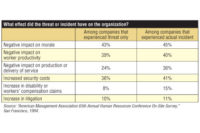Ten Workplace Violence Interdiction & Workplace Security - Safety Tips
1. Review and reissue your Workplace Violence Prevention and/or Harassment Policy Statement annually.
2. Remind supervisors of their responsibility to report, document and investigate every complaint.
3. Take the time to review recent incidents to identify potential gaps in your Violence Response Plan.
4. Remind employees that reporting at-risk situations is their responsibility in emphasizing their value.
5. Conduct a workplace assessment by visual observation and employee questionnaire in identifying potential hazards.
6. Review your visitor protocol policy to include access control for former employees and spouses.
7. Review your Domestic Violence Policy to ensure employees know what services are offered.
8. Update your emergency evacuation plans to include drills for Hostile Intruder and Safe Room Procedures.
9. Review the last time a full emergency evacuation drill was conducted, and determine if you and your employees are prepared for chemical, weather, fire, bomb or hostile intruder threats.
10. Update your New Employee Orientation to include Workplace Violence Policy, Procedures and Guidelines.
According to the latest statistics, an astounding two million workers in America are victims of some form of workplace violence each year, and workplace violence now ranks among the top four causes of workplace deaths. As last reported in 2010, 18 percent of U.S. workplace fatalities were the result of workplace violence. Compare that to 14 percent of U.S. fatalities caused by falls. It’s especially alarming that the number of incidents involving multiple fatalities have increased – a concern associated with school violence, domestic and partner violence, and armed robbery.
In an effort to address the increasing number of workplace deaths due to incidents of workplace violence in general, and to protect workers from workplace violence, the United States Occupational Safety & Health Administration (OSHA) recently launched an initiative against workplace violence and has identified numerous industries and businesses with a high potential for workplace violence. Such businesses include those where workers exchange money with the public or work at night, and healthcare and social workers who deliver services to the public.
In accordance with the new directive, OSHA plans to conduct inspections of these businesses to determine whether employers are taking sufficient preventive steps to reduce the risk of workplace violence. Of particular concern is that employees can anonymously file complaints against employers who fail to provide for safe and secure workplaces.
To address and prevent potential incidents of workplace violence, OSHA recommends that employers that the following actions:
- Regularly conduct hazard analyses;
- Implement engineering controls (e.g., alarm systems, metal detectors, closed-circuit video recording, lighting, etc.);
- Enforce policies that require employees to use proper personal protective equipment in appropriate circumstances; and
- Establish written programs to protect employees from workplace violence.
Under the new OSHA Directive on Workplace Violence, employers will be cited it they do not take precautionary steps to protect their employees from the potential harm of workplace violence. As such, all employers should evaluate their own potential for workplace violence and consider the feasibility of the following preventive steps:
- Create and communicate a written policy on workplace violence and procedures to be followed in response to a violence incident;
- Complete a workplace hazard assessment and security analysis;
- Create a complaint mechanism for reporting threats or concerns of violence;
- Develop a response team for immediate care of victims of workplace violence;
- Develop appropriate training; and
- Develop new employee orientations on workplace violence prevention.









